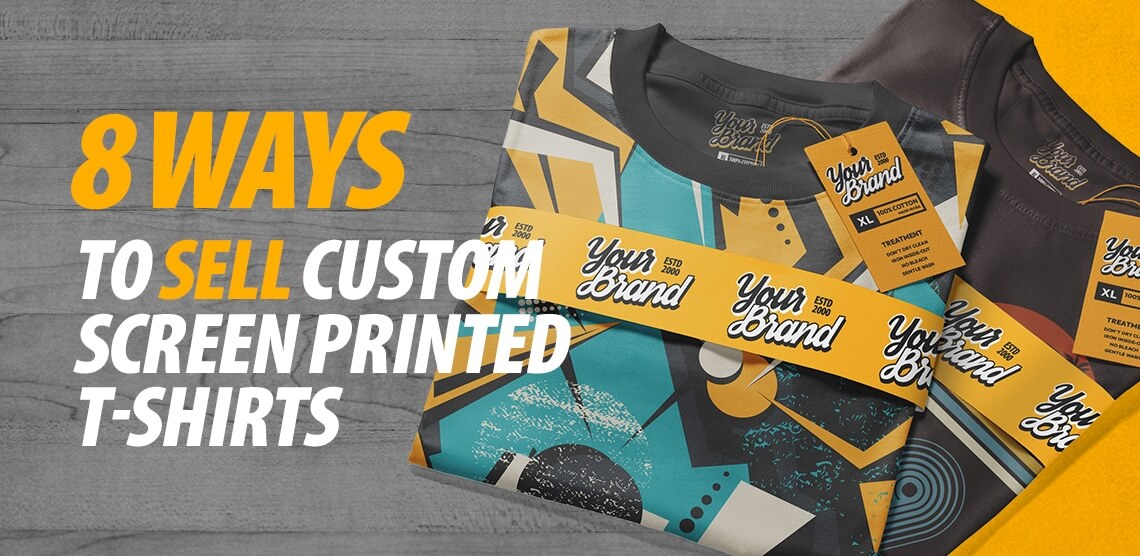Vintage Style Silk Screen Printing for Retro Fashion
Vintage Style Silk Screen Printing for Retro Fashion
Blog Article
Display Printing Uncovered: Everything You Need to Know Concerning Tee Shirt and Garment Printing Techniques
If you have actually ever questioned how those lively styles wind up on your favored t-shirts, you're in the appropriate location. Display printing is a remarkable approach that combines art with technique, offering endless opportunities for imagination. Comprehending the fundamentals, from devices to ink options, can greatly impact your results. Ready to explore the crucial components that make display publishing an art type? Allow's discover the details that can raise your jobs.
The Fundamentals of Display Printing: Exactly How It Functions
When you plunge into display printing, you'll find it's both a science and an art. At its core, screen printing entails producing a pattern, or screen, that allows ink to go through just in certain locations (screen printing kit). You start by selecting your design and preparing your screen with a light-sensitive solution. When you reveal this emulsion to light, it sets, leaving your design as a negative room.
Next, you'll mix your inks and prepare your printing surface area. Setting the display over the textile, after that utilize a squeegee to push ink through the display onto the garment. This procedure needs accuracy, as you want clear, vibrant prints. After printing, you'll heal the ink with warm, ensuring it follows the material and lasts via laundries. Each action is vital, and mastering them will raise your display printing skills, changing basic garments right into one-of-a-kind, meaningful items.
Kinds of Screen Printing Strategies
Once you realize the essentials of display printing, it's time to check out the different techniques that can boost your styles. One preferred technique is traditional screen printing, where ink is pushed through a stenciled screen. This method is excellent for strong, dynamic colors. There's water-based ink printing, which offers a softer feel and is green, yet it calls for a different method to curing.
Another alternative is plastisol printing, understood for its longevity and brilliant shades, making it a favorite for many brand names. Experiment with halftone printing to develop slope results and detailed styles.
Essential Equipment for Screen Printing
To accomplish magnificent outcomes in screen printing, having the ideal devices is essential. You'll need a sturdy display printing structure, which holds the mesh that transfers your style onto the garment. Next, invest in top quality mops; these are important for applying ink equally throughout the display.
Picking the Right Inks and Materials
When choosing inks and products for display printing, you require to think about the kind of ink that functions ideal for your job. Think of textile compatibility to guarantee your styles look great and last long. Likewise, check out eco-friendly ink options to make your printing process much more sustainable.
Types of Screen Inks
Choosing the right screen ink is necessary for achieving dynamic, resilient prints that satisfy your task's demands. There are numerous kinds of display inks to examine. Specialized inks, such as metallic or glow-in-the-dark, can add one-of-a-kind impacts to your designs.

Fabric Compatibility Factors To Consider
Understanding textile compatibility is essential for achieving premium screen prints, especially because various materials react distinctly to numerous inks. When picking inks, consider the material kind-- cotton, polyester, or blends. For cotton, water-based inks work well, using gentleness and breathability. Polyester, on the various other hand, often requires plastisol inks for better bond and vibrant shades. If you're printing on blends, you may require to use a combination of both types. Always examine your inks on sample fabric to assure they stick correctly and keep shade honesty. In addition, bear in mind that fabric weight and structure can affect the last end result, so choosing the ideal ink and material combo is crucial for your job's success.
Eco-Friendly Ink Options
Green inks are becoming a preferred option for display printers who intend to reduce their ecological impact while maintaining high quality. When choosing inks, consider water-based inks, which are much click here for more info less dangerous and simpler to tidy up contrasted to standard solvents. These inks bond well with fabrics, supplying lively results without hazardous chemicals. You might also check out eco-solvent inks that make use of fewer unpredictable organic substances (VOCs), making them a safer choice for both your health and wellness and the earth.
Furthermore, search for inks made from eco-friendly sources, such as soy or vegetable-based alternatives. By choosing the right inks and materials, you'll not just create sensational designs however additionally add to an extra lasting printing process. Make the button, and your prints will reflect your commitment to the atmosphere!
Preparing Your Layout for Display Printing

Submit Format Needs
To assure your design looks sharp and vibrant on fabric, you'll require to pay close attention to submit format demands for display printing. Make certain your style has a transparent background to avoid unwanted white sides on your prints. Maintain shade modes in mind; CMYK is basic for screen printing, so transform your RGB designs appropriately.
Color Splitting Up Methods
Shade splitting up is an essential step in preparing your design for screen printing, and understanding it can significantly boost your print high quality. You'll need to break your layout into private colors, as each shade requires a separate display throughout printing. This accuracy not just assures accurate color depiction however additionally simplifies the printing procedure.
Resolution and Dimension
Accomplishing the finest results in screen printing begins with guaranteeing your style has the ideal resolution and size. Preferably, your art work should be at least 300 DPI (dots per inch) for sharp, clear prints. If you use lower resolution, your final product might look less than professional and pixelated.
When it involves dimension, consider the measurements of your print area. Design your artwork to match the final print dimension, ideally developing it in the real measurements you'll be printing. By doing this, you'll prevent any kind of unanticipated scaling problems.
Always inspect your design in both vector and raster styles. Vector graphics can be scaled without shedding high quality, making them ideal for display printing. Preparing appropriately will ensure your design looks amazing on every garment!
Step-by-Step Display Printing Refine
Screen printing is a dynamic procedure that allows you to create vibrant styles on numerous surfaces. To obtain begun, you'll need a display, emulsion, and your picked ink.
Pour ink onto the screen and make use of a squeegee to press the ink via the pattern onto the textile. Lift the screen thoroughly and allow the print completely dry. You've successfully display printed your design.
Tips for Effective Screen Printing Projects
While you're diving right into your over at this website screen printing projects, keep in mind that prep work is key to success. Beginning by collecting all your materials-- inks, garments, mops, and displays. A tidy work space helps prevent unwanted errors, so neat up prior to you start.
Following, validate your artwork is high-resolution and effectively sized for your garment. Test your display for proper exposure and tidy it extensively to this page avoid spots. When mixing your inks, follow the maker's standards to accomplish the best uniformity.
During printing, apply also stress with your squeegee for regular outcomes. Do not rush; take your time to confirm each print satisfies your criteria. After printing, allow your garments dry completely prior to handling or packaging them.
Finally, always keep a sample of your benefit future referral. This way, you can evaluate your development and improve your strategies in time. Satisfied printing!

Frequently Asked Questions
Just how Long Does It Require To Establish up a Screen Printing Job?
Establishing up a display printing work normally takes around half an hour to an hour. You'll prepare the screens, mix inks, and adjust the press. The moment varies based on intricacy and experience, so stay arranged!
Can I Print on Various Material Enters Utilizing the Exact Same Method?
Yes, you can publish on different textile types utilizing the same technique, yet you'll require to readjust your inks and settings. Some materials soak up ink differently, so exploring guarantees the very best results for every product.
What Prevail Mistakes to Prevent in Display Printing?
When screen printing, prevent common blunders like using the incorrect ink, overlooking appropriate exposure times, or avoiding pre-press checks. Constantly examine your configuration and preserve tidy displays to ensure quality results each time.
How Can I Correctly Clean and Preserve My Display Printing Equipment?
To appropriately clean and keep your screen printing tools, you should routinely clean screens with ideal solvents, examine mops for wear, and assure all devices are stored completely dry and dust-free. Uniformity improves and protects against costly fixings efficiency.
Is Display Printing Eco-friendly Contrasted to Various Other Approaches?
Display printing can be a lot more eco friendly than other approaches, specifically if you use eco-conscious materials and water-based inks. By picking sustainable materials and techniques, you minimize waste and minimize your influence on the planet.
Screen Printing Uncovered: Everything You Required to Know About T-Shirt and Garment Printing Techniques
At its core, display printing involves producing a stencil, or display, that allows ink to pass through only in specific locations. Position the display over the textile, after that make use of a squeegee to press ink with the display onto the garment. One prominent technique is standard display printing, where ink is pressed with a stenciled display.When picking inks and materials for screen printing, you need to take right into account the kind of ink that functions ideal for your task.
Report this page